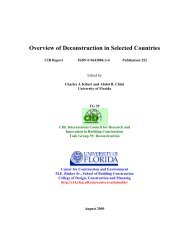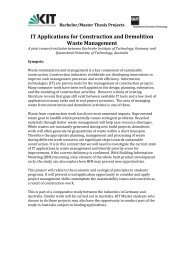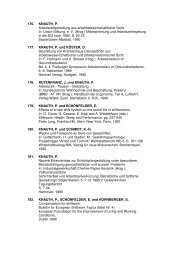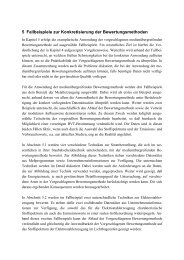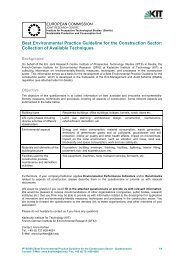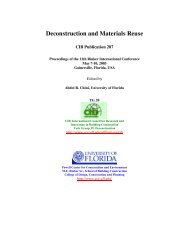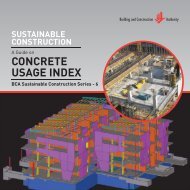Waste reduction final report -4 - Test Input
Waste reduction final report -4 - Test Input
Waste reduction final report -4 - Test Input
You also want an ePaper? Increase the reach of your titles
YUMPU automatically turns print PDFs into web optimized ePapers that Google loves.
It is recognized that lean concrete will be the place for recycled mixed aggregates. It can be<br />
introduced at many places on the construction site without problems. Examples for this (and<br />
for other types of recycling concrete, too) are given in two brochures by the canton of Geneva<br />
[GE 2009]. In order to transfer the current knowledge to the regarding persons and to<br />
overcome prejudices, the project “gravel for generations” has been started.<br />
Another discussion point concerns possible pollutants in mixed mineral material and their<br />
behaviour. In Switzerland, a study was accomplished about pollutants in secondary<br />
construction material in general [VSS 2002].<br />
Secondary construction materials do not contain many pollutants; additionally, most of them<br />
are inorganic. Indeed, concentrations of chemicals are higher in recycled mixed aggregates<br />
than in other secondary materials. The authors claim that high quality requirements for all<br />
secondary materials would ensure security for human beings and the environment. This way,<br />
accumulation of pollutants such as nitrogen compounds or chromium in ground water is<br />
avoided.<br />
Asphalt<br />
About 50% of asphalt waste is used directly on site, e.g. by a procedure using heat; the other<br />
50% are recycled into recycled asphalt aggregates or landfilled. However, there are hold<br />
some discussions about the recycling of asphalt: A total of about 6 MT pavements contains<br />
tar, which corresponds to about 5% of the total embedded asphalt [ARV 2008]. Abrasion<br />
of material comprising PAH can trigger health problems.<br />
Today, materials with more than 20,000 mg PAH per kg binding agent are allowed only to be<br />
used with restrictions and current policy works suggests to sort out and eliminate the tarcontaining<br />
fraction [FOEN 2008c]. In contrast to this, the industry claims that there exist<br />
methods for a safe reuse of these materials [Killer 2008]. Even so, the next revision of the<br />
ChemRRV will probably implicate a prohibition of new bitumen containing road surfaces<br />
and PAK parts in the upper layers of roads [Stadt Zürich 2007]. The binding material shall be<br />
taken out of the cycle by incineration.<br />
Excavation material<br />
Excavation material is generated in high amounts, contaminated (only 5-10%) or pollutionfree.<br />
As there is no obligation to capture the amount, only estimations can serve as lead.<br />
Today, estimations give figures around 40 to 60 Mm 3 per year, and given that big projects<br />
and high construction activity are expected, this figure will rise in the next years. Today, the<br />
material is mainly used for backfilling or reclamation of gravel pits or construction sites. The<br />
remaining parts are used in another form or are landfilled.<br />
Depending on the canton’s space availabilities, scarcity of landfill space will become an<br />
urgent problem. Today already, materials are transported over big distances with lorries. The<br />
current TVA revision will deal with this problem. Materials with good construction<br />
properties can be used as construction materials, but for the remaining parts, solutions for insitu<br />
or other use of excavation have to be established. A study accomplished by the<br />
Hochschule für Technik, Rapperswil was ordered by the FOEN [FOEN 2008b]. The study<br />
compiled examples of sustainable in-situ use of excavation materials in landscape forming.<br />
Identified problems concerned the quality of the remaining excavation material, space<br />
constraints and interim storage. Furthermore, it concluded that it was easier to reuse<br />
excavation material at big construction sites than at smaller ones. From the economic side of<br />
104



